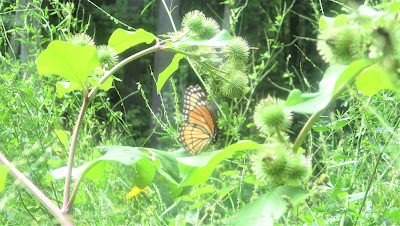We wondered what on Earth it was when we stopped to look a little closer at one of the many Staghorn sumacs growing in the forest. They all eventually develop a fruiting body, clusters of bright red berries tightly packed in a candle form. The candles last throughout the winter and provide a winter food-source for many birds. They're an attractive tree, not very tall, but make a lovely show in the fall when the foliage turns bright orange, yellow and red, especially seen in a grouping.
 |
The reason we stopped to examine this one more closely was the odd formation of little round balls on the underside of its leaf-bearing stems. Some of the balls, about the size of a small plum, were green, and some were turning a blush pink, or red. Later, doing a little sleuthing, we discovered they were caused by aphids, special to sumacs, called aphid galls.
The forest is saturated from all this summer's ongoing rain events, but we're becoming accustomed to it. The compensation is the vibrant colours that ensue after a rain. As well as the fact that all the vegetation has responded by enormous spurts of growth. We've never before seen such a growth eruption, from ragweed to burdock and milkweed, jewelweed, black-eyed susans and compass plants.
We took our hike through the ravine a little early in the afternoon of a day that alternated between heavy overcast and occasional sun. But it looked as though we might evade rain today, and that was fine with us. Jackie and Jillie were as eager as always to get out for their hike through the forest trails. They would miss terribly not being able to poke about here and there, and catch up to the latest canine neighbourhood news.
We were delighted at one point to realize that a newly-emerged Monarch had suddenly appeared as we walked toward a mass of grown-tall bracken, stuffed with ragweed and burdock. The butterfly was flitting about here and there erratically, seemingly unwilling to settle down in any one spot. Until it approached a large burdock and finally landed on a leaf, and began drying out its still-wet wings.
Repeatedly folding and unfurling them, although by then the sun had gone in again. New life in the forest. We haven't seen that many Monarchs or any other colourful butterflies around this year. And not many dragonflies either, although there are always white cabbage butterflies around. And plenty of Japanese beetles. Best of all, bees, busy at the flowers in the pollinating garden.
Where great swaths of fleabane and flowering clover are in bloom, and those beautiful primroses and purple loosestrife wildflowers. Among them intruders like wild garlic and wild parsnip elbowing their way through the native species and proliferating wildly.
Irving did barbecue for dinner tonight. He used the panfry option for potatoes, and made a delicious batch of chicken drumsticks. Much earlier in the day I had prepared a fresh coleslaw to accompany dinner. While he was out on the deck at the barbecue monitoring dinner there was plenty of blue sky. There still was blue, among the clouds moving in, but we hardly suspected that as soon as everything was in the house and we were sitting down having our dinner, the sky would open up yet again. timing is everything...






No comments:
Post a Comment